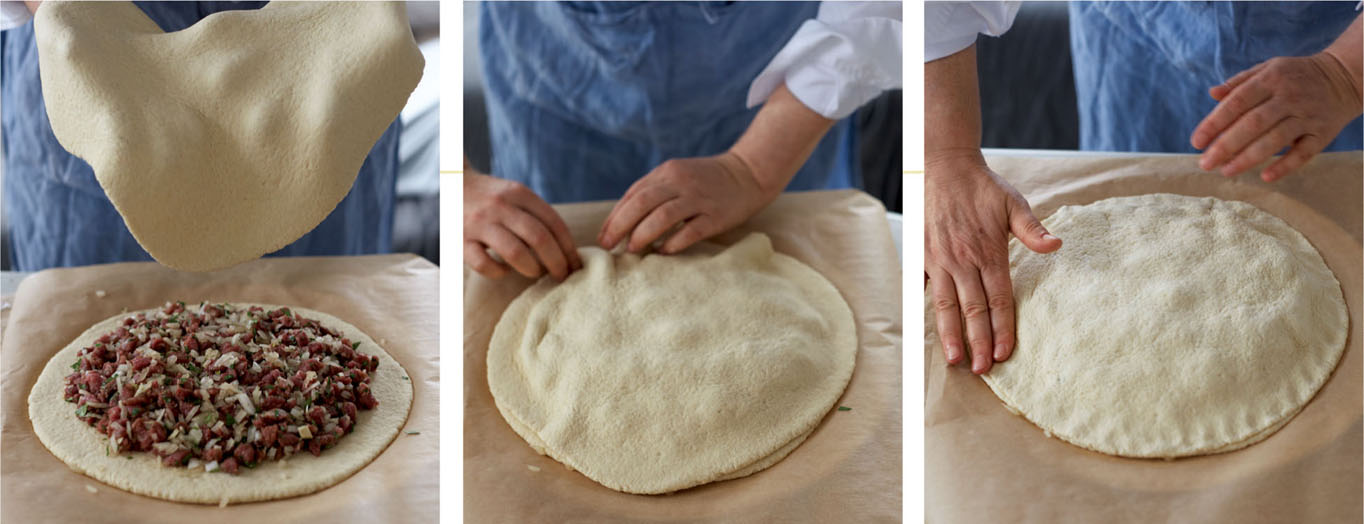MEDFOUNA
MOROCCO

Medfouna, which means “buried” in Arabic, is a confusing name for this filled bread as it also describes a Moroccan dish where stewed pigeons are buried under a mound of steamed vermicelli. I am not sure why both dishes share the name. All I know is that this bread is a southern specialty. I initially saw the recipe on a postcard while browsing through a rack of them in Marrakesh. The name of the bread also refers to the fact that the bread is baked on a hot stone, buried under hot ashes—which is how it’s done in most southern areas, although in other, more northern areas, the bread is baked in regular wood-fired ovens. You can use ground lamb as in the recipe below, or if you can get it, use knlii (dried strips of spiced beef that are simmered in clarified butter, or smen as it is known in Morocco) for a much stronger flavor. Some cooks add chopped or sliced hard-boiled eggs to the filling. I prefer the bread without.
SERVES 6 TO 8
FOR THE FILLING
1 pound 6 ounces (650 g) well-trimmed lamb shoulder (from about 2¼ pounds/1 kg), cut into tiny dice (see Note)
1 large onion (7 ounces/200 g), very finely chopped
A few sprigs flat-leaf parsley, finely chopped
1 tablespoon ground coriander
½ teaspoon ground cumin
½ teaspoon ground cinnamon
1 teaspoon finely ground black pepper
1 teaspoon fine sea salt, or to taste
¼ cup (60 ml) extra-virgin olive oil
FOR THE DOUGH
2 cups (240 g) unbleached all-purpose flour, plus more for kneading and shaping
1⅓ cups (220 g) fine semolina or semolina flour
1½ teaspoons instant (fast-acting) yeast
1½ teaspoons fine sea salt
1. To make the filling: Mix together the lamb, onion, parsley, spices, and oil in a large bowl. Let marinate, stirring occasionally, while you prepare the dough.
2. To make the dough: Mix the flour, semolina, yeast, and salt in a large bowl and make a well in the center. Gradually add 1⅓ cups (325 ml) warm water, bringing in the flour as you go along. Knead until you have a rough ball of dough.
3. Transfer the dough to a lightly floured work surface and knead for 3 minutes. Shape the dough into a ball, invert the bowl over the dough, and let rest for 15 minutes. Knead for 3 more minutes, or until the dough is smooth and elastic. Shape into a ball and place in a clean, lightly floured bowl. Cover with plastic wrap and let rise in a warm, draft-free place for 1½ to 2 hours, or until doubled in size.
4. Transfer the dough to a lightly floured work surface. Divide into 2 pieces, one slightly larger than the other. Roll each piece into a ball and place on a floured surface. Sprinkle a little flour over the balls. Cover with a clean kitchen towel and let rest for 15 minutes.
5. Roll out the smaller piece of dough to a round 12 inches (30 cm) in diameter. Be sure to sprinkle your work surface and the top of the dough with flour every now and then so it doesn’t stick. Transfer the round of dough to a large nonstick baking sheet (or a regular baking sheet lined with parchment paper or a silicone baking mat). Prick with a fork here and there. Spread the meat filling evenly all over, leaving about ¾ inch (2 cm) free around the edges. Brush the edges with water. Roll out the other piece of dough to a slightly larger round. Carefully lay over the filling, making sure you align the edges. Press on the edges slightly to seal. Prick the dough in a few places. Cover with a damp kitchen towel and let rise for 30 to 45 minutes, depending on how warm your kitchen is. If too warm, go for the shorter rise time.

6. Preheat the oven to 375°F (190°C).
7. Uncover the bread 5 to 10 minutes before putting in the oven to let the top dry out. Place in the oven and bake for 45 minutes, until golden all over. Remove from the oven and let the bread rest for 5 minutes before transferring to a wire rack to cool slightly—you may have to drain off the excess juice that will have seeped out from the meat. Serve hot or warm. You can let the bread cool on the rack completely and freeze it for later use. Keep the bread wrapped as it is thawing. Once thawed, reheat in a 400°F (200°C) oven for 10 to 15 minutes and serve.
NOTE: You can chop the meat in a meat grinder, but the texture is much nicer if you hand-cut it.